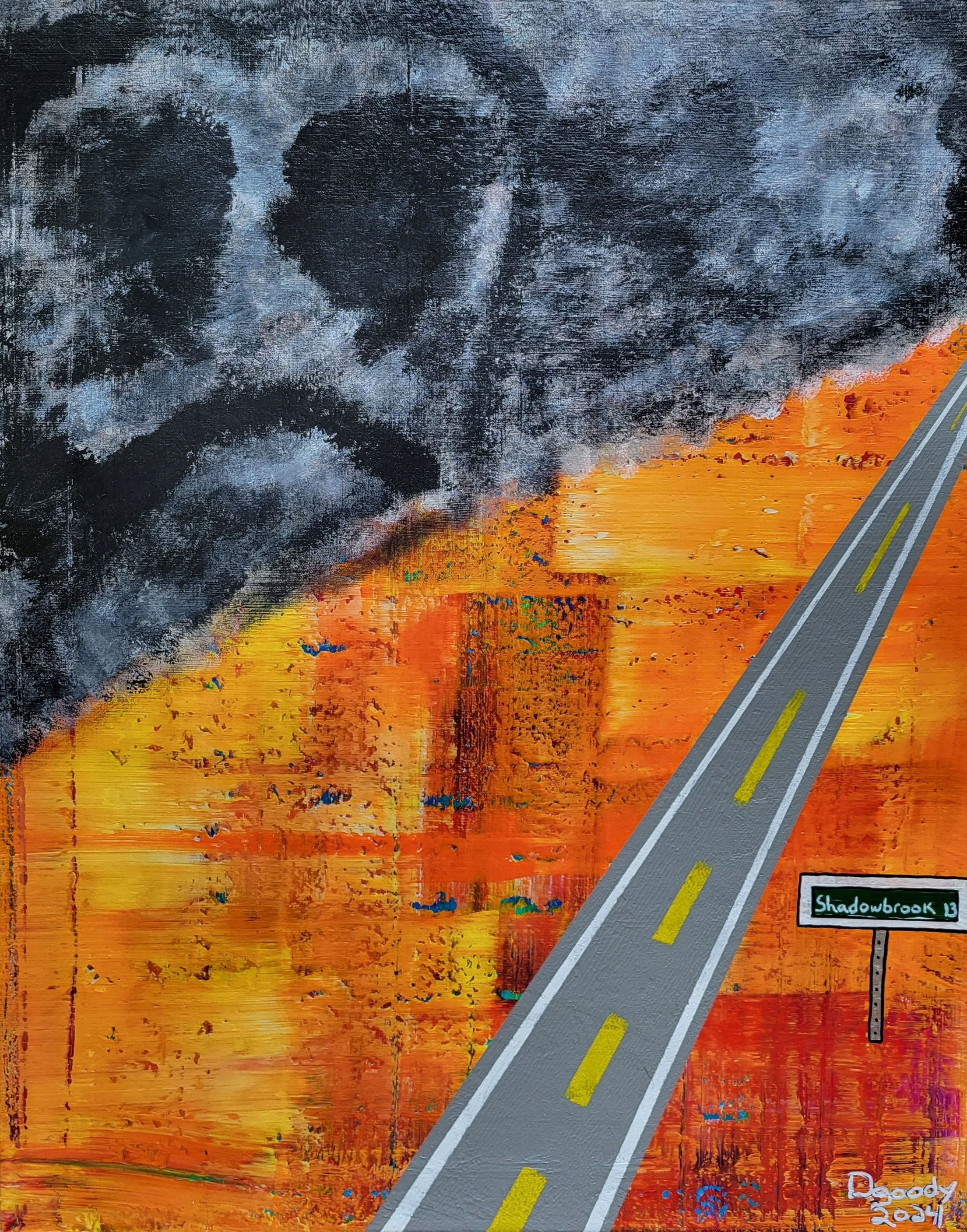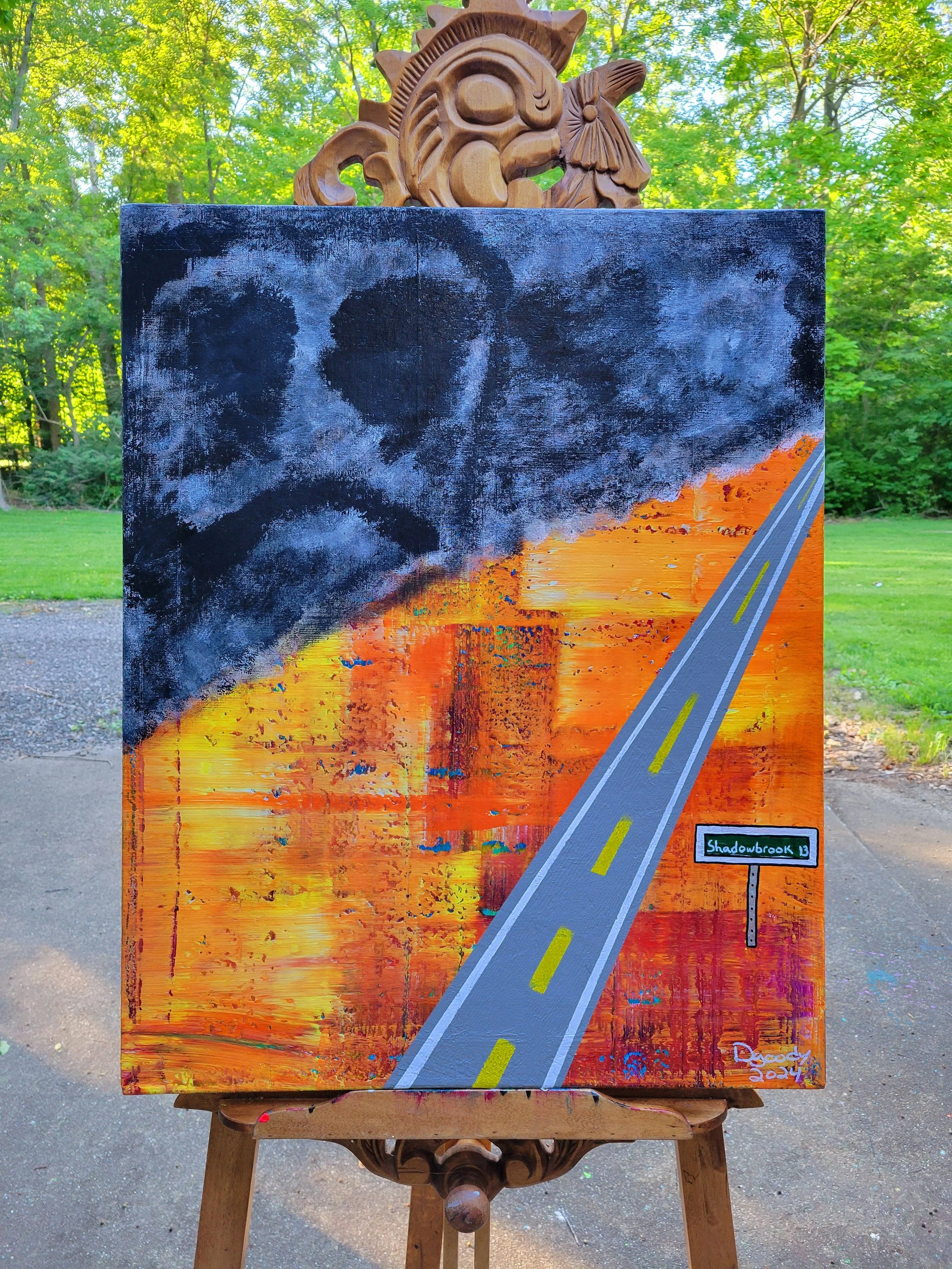Two: “Dark Clouds on Sunny Days”
“Dark Clouds on Sunny Days”. Acrylic on 24 × 30 × 1.5 inch canvas
Shadowbrook is a place that seems to exist between worlds — not quite real, not entirely imagined. To outsiders, it’s a town tucked in a valley, surrounded by towering forests and steep hills that seem to eagerly lean forward, as if trying to keep quiet secrets. To Ansel Kincaid, it’s something more: a mirror of his mind, a landscape shaped by fog and memory, where the weather never seems to completely clear and the past never quite lets go.
The town is known for its gloom. Rain falls like a ritual, mist clings to the trees like breath on glass, and the sun — when it dares to appear — feels like a visitor who only stopped in to ask for directions. Locals joke that Shadowbrook has only two seasons: damp and drenched. But beneath the humor lies a quiet truth. Some people come to Shadowbrook to escape the noise of the world. Others come because they have nowhere else to go.
Ansel arrived here for school but stayed for reasons he couldn’t fully articulate. The town’s melancholy suited him. Its quiet streets, its brooding skies — they felt familiar, like the inside of his own head. He found comfort in the rhythm of the rain, the way it softened the edges of things. In Shadowbrook, no one expected you to be cheerful. You could simply exist.
“Dark Clouds on Sunny Days” in natural light
Geography and Climate
Shadowbrook sits beside the Brookshade River, a slow-moving body of water that reflects the sky like a dark mirror. The river winds through the town like a vein, feeding its mood. The surrounding hills are thick with evergreens, their silhouettes jagged and solemn. Fog rolls in most mornings, blanketing the town in a misty hush that feels almost sacred.
Rain is a daily visitor, and the sun is a rare luxury — a kind of myth whispered about but seldom seen. The air is cool year-round, and the town’s palette is one of grays, greens, and muted blues. It’s a place where shadows linger longer than light.
History and Economy
Founded in the early 1800s by settlers drawn to its fertile soil and abundant timber, Shadowbrook was never meant to be a destination. It was a place to work, to endure, to survive. Over time, its population stabilized with a mix of farmers, foresters, and wanderers who found solace in its isolation.
Today, the economy remains modest. Agriculture persists, though the lack of sunlight limits what can be grown. Forestry is still active, and tourism has become an unlikely lifeline. Visitors come seeking something they can’t quite name — a retreat, a reckoning, a story. They stay in cozy inns, hike through the Misty Woods, and whisper about the haunted manor on the hill.
Culture and Society
Shadowbrook’s culture is shaped by its climate. The architecture is practical and poetic — steep roofs, dark wood, stone foundations that seem carved from the hills themselves. Inside, homes are warm and dimly lit, filled with books, blankets, and the scent of damp earth.
Folklore thrives here. Tales of ghosts, lost travelers, and creatures that dwell in the fog are passed down like heirlooms. The town’s annual GloomFest celebrates its identity with lantern-lit parades, melancholic music, and storytelling sessions that blur the line between fact and fiction.
The people of Shadowbrook are quiet but kind. They understand solitude. They respect silence. They don’t ask too many questions, and they don’t offer easy answers. For Ansel, this has been both a comfort and a challenge.
Notable Landmarks
The Misty Woods: A sprawling forest that surrounds the town, known for its towering trees and perpetual fog. It’s a place of reflection, mystery, and occasional fear.
Brookshade River: The town’s lifeblood, its dark waters winding through the heart of Shadowbrook. Ansel often sits by its banks, sketching or simply watching the current.
Shadowbrook Manor: An abandoned mansion on the outskirts, rumored to be haunted. Its crumbling facade and overgrown gardens are a favorite subject of local artists and storytellers.
The Old Stone Church: Built during the town’s founding, its stained glass windows depict scenes of sorrow and redemption. Ansel visits sometimes, not for faith, but for quiet.
Shadowbrook is more than a setting — it’s a character. It breathes, it broods, it listens. For Ansel, it’s both sanctuary and snare. A place where he can hide, and a place that reminds him he’s hiding. Its dark clouds are not just weather, but metaphor. They reflect the intrusive thoughts that shadow his mind, the fears that filter even the brightest days.
But within that gloom, there is beauty. In the stillness, there is space to heal. And in the quiet, there is the possibility of change.

